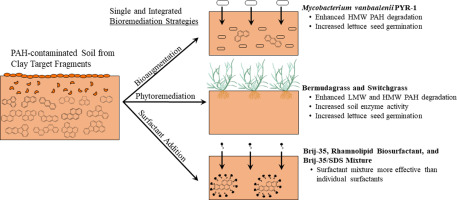当前位置:
X-MOL 学术
›
Sci. Total Environ.
›
论文详情
Our official English website, www.x-mol.net, welcomes your
feedback! (Note: you will need to create a separate account there.)
Bioremediation of PAH-contaminated shooting range soil using integrated approaches.
Science of the Total Environment ( IF 8.2 ) Pub Date : 2020-04-06 , DOI: 10.1016/j.scitotenv.2020.138440 D C Wolf 1 , Z Cryder 1 , R Khoury 1 , C Carlan 2 , J Gan 1
Science of the Total Environment ( IF 8.2 ) Pub Date : 2020-04-06 , DOI: 10.1016/j.scitotenv.2020.138440 D C Wolf 1 , Z Cryder 1 , R Khoury 1 , C Carlan 2 , J Gan 1
Affiliation

|
Serious contamination of polycyclic aromatic hydrocarbons (PAHs) occurs at outdoor shooting ranges due to the accumulation of clay target fragments containing coal tar or petroleum pitch. These contaminated sites are characterized with high-molecular-weight PAHs that are low in bioavailability and recalcitrant to bioremediation. We evaluated the effectiveness of different remediation strategies, used individually or in combinations, to decontaminate PAHs in a shooting range soil. The treatments included vegetation with bermudagrass [Cynodon dactylon (L.) Pers] or switchgrass [Panicum virgatum]), bioaugmentation of Mycobacterium vanbaalenii PYR-1, and addition of surfactants (Brij-35, rhamnolipid biosurfactant, or Brij-35/sodium dodecyl sulfate mixture). The initial total PAH concentration in the shooting range soil was 373 mg/kg and consisted of primarily high-molecular-weight PAHs (84%). Planting of bermudagrass and switchgrass resulted in 36% and 27% ∑16PAH reduction compared to the non-vegetated control, respectively. Bermudagrass enhanced soil dehydrogenase activity and both vegetation treatments also increased polyphenol oxidase activity. Bioaugmentation of M. vanbaalenii PYR-1 had a significant effect only on the dissipation of high-molecular-weight PAHs, leading to a 15% decrease (∑10PAH) compared to the control. In the non-vegetated soil, Brij-35/sodium dodecyl sulfate mixture increased PAH degradation compared to the no surfactant control. The increased PAH biodegradation in the vegetated and bioaugmented treatments improved lettuce [Lactuca sativa] seed germination, suggesting reduced toxicity in the treated soils. Phytoremediation using bermudagrass or switchgrass with bioaugmentation of M. vanbaalenii PYR-1 was an effective in situ remediation option for shooting range soils with heavy PAH contamination.
中文翻译:

使用集成方法对PAH污染的靶场土壤进行生物修复。
由于包含煤焦油或石油沥青的粘土目标碎片的堆积,在室外射击场上会发生多环芳烃(PAHs)的严重污染。这些受污染的部位以生物利用度低且对生物修复具有顽固性的高分子量PAHs为特征。我们评估了单独或组合使用的不同修复策略对靶场土壤中PAHs的去污效果。处理方法包括用百慕大草[Cynodon dactylon(L.)Pers]或柳枝草[Panicum virgatum]进行植被种植,对范氏分枝杆菌PYR-1进行生物增强,并添加表面活性剂(Brij-35,鼠李糖脂生物表面活性剂或Brij-35 /十二烷基硫酸钠)。硫酸盐混合物)。靶场土壤中最初的总PAH浓度为373 mg / kg,主要由高分子量PAH(84%)组成。与无植物的对照相比,种植百慕大草和柳枝respectively分别减少了36%和27%的∑16PAH。百慕大草增强了土壤脱氢酶的活性,两种植被处理均提高了多酚氧化酶的活性。Vanbaalenii PYR-1的生物增强仅对高分子量PAHs的消散具有显著作用,与对照组相比降低了15%(∑10PAH)。与没有表面活性剂的对照相比,在没有植被的土壤中,Brij-35 /十二烷基硫酸钠混合物增加了PAH的降解。植被和生物强化处理中PAH生物降解的增加,改善了莴苣[Lactuca sativa]种子的萌发,提示在处理过的土壤中毒性降低。使用百慕大草或柳枝switch的植物修复以及vanbaalenii PYR-1的生物增强作用是对PAH污染严重的靶场射击的有效原位修复方法。
更新日期:2020-04-08
中文翻译:

使用集成方法对PAH污染的靶场土壤进行生物修复。
由于包含煤焦油或石油沥青的粘土目标碎片的堆积,在室外射击场上会发生多环芳烃(PAHs)的严重污染。这些受污染的部位以生物利用度低且对生物修复具有顽固性的高分子量PAHs为特征。我们评估了单独或组合使用的不同修复策略对靶场土壤中PAHs的去污效果。处理方法包括用百慕大草[Cynodon dactylon(L.)Pers]或柳枝草[Panicum virgatum]进行植被种植,对范氏分枝杆菌PYR-1进行生物增强,并添加表面活性剂(Brij-35,鼠李糖脂生物表面活性剂或Brij-35 /十二烷基硫酸钠)。硫酸盐混合物)。靶场土壤中最初的总PAH浓度为373 mg / kg,主要由高分子量PAH(84%)组成。与无植物的对照相比,种植百慕大草和柳枝respectively分别减少了36%和27%的∑16PAH。百慕大草增强了土壤脱氢酶的活性,两种植被处理均提高了多酚氧化酶的活性。Vanbaalenii PYR-1的生物增强仅对高分子量PAHs的消散具有显著作用,与对照组相比降低了15%(∑10PAH)。与没有表面活性剂的对照相比,在没有植被的土壤中,Brij-35 /十二烷基硫酸钠混合物增加了PAH的降解。植被和生物强化处理中PAH生物降解的增加,改善了莴苣[Lactuca sativa]种子的萌发,提示在处理过的土壤中毒性降低。使用百慕大草或柳枝switch的植物修复以及vanbaalenii PYR-1的生物增强作用是对PAH污染严重的靶场射击的有效原位修复方法。











































 京公网安备 11010802027423号
京公网安备 11010802027423号